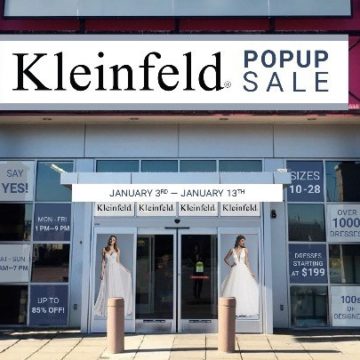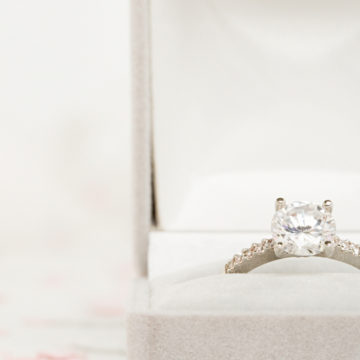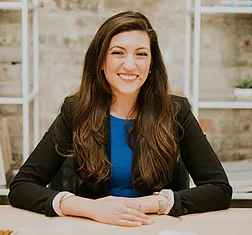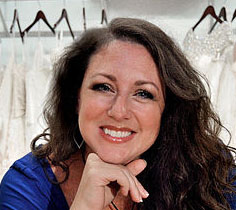Jim Butler and his wife Heather started their bridal business in the fall of 2001.
They grew their business from $0 to over $1,000,000 per year in sales in three years. Jim has helped some of the most respected and largest bridal stores across the country to grow their sales and shatter their previous sales records. Jim is a recognized marketing authority and currently speaks to groups of hundreds of bridal stores giving them training and coaching to improve their businesses each year.
During the coaching, they will cover every aspect of a bridal business from sourcing high-quality, affordable wedding products to being confident about marketing and growing their business. Of course, the type of marketing they do will vary on what their business is and who their target audience is. For example, most bridal businesses can benefit from searching “Brightside digital printers near me” to help get their print marketing off the ground at conventions and trade shows. However, not many businesses will benefit from cold calling unless their business model is B2B. This difference is why so many businesses benefit from their coaching.
Jane Heflin, 38 year veteran of the Bridal industry. Past Director of COUTURE NY Bridal Fashion Week, sponsored by XO, the knot, from 2000-2012. Industry knowledge of Design, Manufacturing, Overseas Product Management and Development, Sales Director, Sales Training and Multi- Retail Store Management.
 For nearly a decade, Shannon Hurd has been editor in chief of VOWS, an international trade magazine for the wedding industry focusing on issues and trends relevant to bridal designers, manufacturers, independent retailers and wedding consultants. Shannon is instrumental in assimilating and communicating current, credible wedding-industry information to VOWS readers.
For nearly a decade, Shannon Hurd has been editor in chief of VOWS, an international trade magazine for the wedding industry focusing on issues and trends relevant to bridal designers, manufacturers, independent retailers and wedding consultants. Shannon is instrumental in assimilating and communicating current, credible wedding-industry information to VOWS readers.
Since 1999, Michael has hopped coast to coast and around the world, leading Alfred Angelo Bridal Inc, into the new millennium. As VP of Design and Merchandising at Alfred Angelo he kept the collections fresh, fashion-forward and timeless for thousands of brides across the globe. He also has worked directly with Disney Consumer Products to develop and launch Disney’s Fairy Tale Weddings Collection.
Michael has appeared on Good Morning America, Get Married TV, E! and The Knot Live. His multifaceted bridal designs have scored covers of magazines including Brides, The Knot, Get Married, Martha Stewart Weddings and Elegant Bride.
Now, Michael Shettel has teamed with bridal industry veterans to launch Gather & Gown, a new global online destination for today’s bridal party. They decided it should be as much about helping you find style, quality, and value for the wedding day as sharing the experience with friends.
This is the Transcript of the #WeddingMarket Chat on November 19th, 2014 with James Butler, Shannon Hurd, Jane Heflin and Michael Shettel. The answers were made on Twitter so responses will appear different.
Q1: How did you get involved with the bridal market?
Answer
Michael Shettel: Involved in design for 25 years and 15 in bridal design.
Shannon Hurd: I’ve always loved business & bridal. These joint passions led me to VOWS; I’ve been editor in chief for nearly a decade.
Jane Heflin: I was in the industry approx 26 years and was hired to help run the New York Bridal show back in 2000- then known as WeddingChannel Couture Show and promoted to Director of the show in 2004.
Jim Butler: Attended first market in Las Vegas September of 2001 prior to opening our store in November of that year. Overwhelmed best fits how I felt. It took several visits and the help of other great bridal retailers who helped guide us through the initial learning steps. It got better with time and with help. Mapping out a plan for who to see and what to buy before you go. Now I would advise: Learning terms for gowns, know what is selling now before buying, stick to your plan and don’t go over budget.
Q2: How would you describe your role in the bridal market?
Answer
Michael Shettel: My designs have been on brides and bridal parties in the USA around the globe.
Shannon Hurd: I’m editor in chief of VOWS, an international trade magazine for the wedding industry. VOWS covers issues/trends relevant to bridal designers, manufacturers, independent retailers & wedding consultants. Bridal markets are an integral part of the wedding industry. As such, VOWS regularly attends & covers them.
Jane Heflin: My main role was to produce a cohesive show that brought new and established talent to the retailer and press in all price points to view product for the next season
Jim Butler: Buyer AND Visiting with friends, learning from seminars, teaching seminars, observing new trends, watching shows, discussing order with sales reps.
Criteria to Buy:
1) What’s selling now and where do trends seem to be heading?
2) What line will give me the greatest visibility, exclusivity, and margin?
3) What season is approaching and what is needed to meet the demands of the marketplace?
My buying strategy at market:
1) Get a general feel of who is there, who is not there, and what new vendors may be of interest
2) See vendors representing top selling bridal and prom lines. Look and consider top picks. Wait to place order until after I’ve seen it all
3) After dresses, look at veils, tiaras, and other accessories. Increase stock or look for items that can fill holes.
4) Consider new vendor possibilities.
5) Network with friends and industry peers who I can learn from. To me, market is about ROI: Relationships, Outcomes, Improvements
Q3: How does a concept for a bridal design come about?
Answer
Michael Shettel: Designs are inspired by all things in society but brides and brides to be are my biggest in inspiration.
Shannon Hurd: It typically begins as a designer’s inspiration, which can come from a variety of sources. It’s also influenced by current pop culture. Disney “Frozen”-inspired dresses are hot right now.
Jane Heflin: Usually it comes from the current trends of fashion and what is selling from the season before. Also from European designs 1-2 seasons before.
Jim Butler: 6-9 months before market: designers submit designs and receive design ideas from factory designers, designers select which gowns to offer Design teams prep samples, photograph, get feedback from their best accounts, offer preliminary showings, receive orders, then to market. Many gowns are cut from lines before they are even seen by store owners – gowns don’t fit right, beading patterns are incorrect, etc. Market decides what will sell – many gowns are cut before they are ever sold due to lack of response of buyers. Best designs are often tweaks of best selling designs from other designers or re-imagined ideas from the past. Hours and hours go into planning, sketching, selecting materials, approving a sample BEFORE it ever is seen by store owners and brides.
Q4: How does a designer/manufacturer
Answer
Michael Shettel: We review to make the strongest selection to the consumer in style, quality and price.
Shannon Hurd: Typically they sketch out a design, create the garment, put it on a fit model and evaluate/revamp until they’re satisfied. It’s a continuously evolving process from paper to finished product.
Jane Heflin: Dresses are included by diversity of style,cost, price point,retailer focus review and consumer needs.
Jim Butler: Designer/manufacturer has to go off their own instinct about where the market will be and is very difficult (right at times, wrong others). Many factories have their own design teams and actually design the best-selling gowns – they have a good sense of the market. Sales ultimately determine what gets put onto a dress line. If it sells it stays, if it doesn’t, it is gone. Surprisingly, more often than not, what designers think may be a good idea is cut before the dress is. Biggest designers often have preview shows with their best accounts. Dresses received well are photographed and promoted. Dresses that are pictured and promoted are sold. So, if a dress is well received and orders are strong, the dress will be promoted more.
Q5: What is Bridal Fashion Week?
Answer
Michael Shettel: Bridal Fashion week is a way to showcase new designs to a worldwide consumer and editorial audience. LOTS OF FUN!!
Shannon Hurd: Technically it’s no longer just a week. There are bridal fashion events across the country twice a year. It’s an opportunity for designers and manufacturers to showcase their collections to wedding professionals and media. Bridal retailers attend to see new collections & make purchases for their salons. There are also great networking opportunities and informative business seminars.
Jane Heflin: Bi yearly trade show that brings retailers, designers, manufactures and press together to review and purchase for the following season. This process takes place in 5 regions across the states.
Jim Butler: Bridal Fashion Week is the time when designers showcase their new collections to stores who travel from around the world for market. Lines may be trimmed between market locations based on the response of the buyers to the gowns.
Q6: How many different cities around the world hold a bridal market event for bridal shop owners?
Answer
Michael Shettel: #bridalmarket events are held in many major cities, Chicago, LA, NYC, Barcelona, London and more.
Shannon Hurd: In the U.S. bridal markets are held in Chicago, N.Y., Dallas, L.A. & Atlanta. Worldwide they’re also held in major regions including Spain, Italy, Germany, France, England and UAE, among others.
Jane Heflin: The major shows- New York, Chicago, Atlanta, Dallas, and LA- Europe/ London, Harrogate, Barcelona, Milan, Paris, Netherlands, Germany and etc.
Jim Butler: In the U.S., Atlanta, Dallas, Chicago, and New York are the primary markets. There are also private buying markets as well. I haven’t personally attended any of the markets outside of the U.S. so someone else can probably address these locations.
Q7: Is Bridal Fashion Week open to the public?
Answer
Michael Shettel: Traditionally bridal markets are not open to the public, but I love having design students participate with fashion shows.
Shannon Hurd: No, although I’m sure brides would love to be there!
Jane Heflin: NO.. only business to business- Retailers/ Press.. recent 6 yrs it has opened up to ” Bridal ” press via bloggers, tweeter and other internet outlets.
Jim Butler: No. Retailers need to show proof of store ownership before they are allowed onto the showroom floor.
Q8: How does Bridal Fashion Week help designers get their dresses into bridal shops?
Answer
Michael Shettel: Bridal Markets allow seasonal collections to be show to store buyers and press…its exciting!!
Shannon Hurd: It puts their gowns front and center in front of salon owners, who can make purchases on the spot .
Jane Heflin: A central location to present their product to the retailers and press hoping for exposure, editorial that drives consumer interest, drives the retailer to purchase product.
Jim Butler: Bridal Fashion Week helps designers showcase their new lines and product to buyers. Fashion shows and sales reps get to know many buyers and sales reps usually invite buyers to come to see shows. Following markets, most sales reps go on the road and receive orders from stores that didn’t attend markets.
Q9: Why do some dresses make it into the bridal shops and others do not?
Answer
Michael Shettel: Some dresses are great and others are not beauty is in the eye of the beholder all subjective and fun.
Shannon Hurd: Salons choose gowns that best appeal to their customer base. Knowing and buying for your individual market is crucial.
Jane Heflin: Dresses are picked by price point, marketing behind the dress/ company, creative cutting edge design, consumer demand, restricted/ exclusive distribution and Min required to buy the line.
Jim Butler: Preference of the buyer. They know what sells and what won’t. 1st time buyers often overbuy. Seasoned buyers buy more carefully.
Questions buyers typically ask:
1) Do I really need this dress?
2) If a competitor had it, would my business go on?
3) How much can I really commit to this line in comparison with everything else I am buying?
4) Will the company I am buying from support my business or will they sell to all of my competition too (especially geographically)?
Q10: How longs does it take for dresses to get into stores after bridal market events?
Answer
Michael Shettel: All dresses can be found location and proximity could be difficult sometimes. If you fall in love with a dress, keep searching until you find it and try it.
Shannon Hurd: Generally three months. In the U.S. dresses are ordered at bridal markets in March/April and again in Sept/Oct .
Jane Heflin: Depending on time of year- 3-6 months- some Manufactures can deliver in 6-8 weeks.
Jim Butler: Depends on the manufacturer. Some pre-order and ship faster based on initial response from best buyers. Usually 4-5 months after. Dresses that come faster were ordered before market or are rush shipped based on demand and shipping method (speed).
Q11: Even if a dress gets tons of press & brides fall in love with a dress does that mean she will be able to find it?
Answer
Michael Shettel: All dresses can be found but location and proximity could be difficult sometimes. If you fall in love with a dress, keep searching until you find it and try it.
Shannon Hurd: No guarantees but most stores love carrying dresses that get tons of press. They’re typically very easy to find.
Jane Heflin: Yes, if she contacts the manufacture to find the store where to purchase unless the company dropped dress from the line.
Jim Butler: No. If a manufacturer promotes it, yet buyer doesn’t bring it in, it may not be available to be seen in person. Some retailers don’t buy the most heavily promoted dresses because brides will buy solely on price and try to find it for less. The bottom line is that bridal retailers will bring in what sells. If it is selling, they will keep bringing it in. Stores may experiment with new trends, but most adopt a wait and see strategy. Trends adopted when more designers have and over time.
Q12: What were some of the new trends that you saw at Bridal Fashion Week this year?
Answer
Michael Shettel: Bridesmaids were freshly colored in pastel tones as well as beautiful blush tones and bridal is all about bit of color.
Shannon Hurd: Many current trends remain strong including lace, back treatments, strapless gowns & fit and flare. Ball gowns are also trending right now.
Jane Heflin: More diversity in style of dresses, fabrication, cap sleeves, more back detail and sheerness through the body torso.
Jim Butler: Dresses with detailed back treatment are very popular. Low back, sheath gowns, lace. Sheath gowns with lace and illusion necklines continue to be a big trend.
Q13: How does a bridal shop purchase dresses from designers/manufacture?
Answer
Michael Shettel: CASH CASH CASH…international buying language.
Shannon Hurd: They buy dress samples at market, which brides then try on in-store. After the bride purchases a dress, she is measured and a dress is custom made to fit her body. Dresses can also be purchased through manufacturer/designer sales reps. Many visit bridal salons regularly.
Jane Heflin: Contacting the Manufacture/ Rep to see if the territory is open, fulfilling the min dress buy requirements and keeping the re-order/ buy ratio needed each season required by the company.
Jim Butler: They usually leave an order with their sales rep after seeing the dress line in its entirety. Retailers typically have to purchase a minimum number of dresses from each designer or collection. Some manufacturers are more stringent than others with their minimum policy. Ask your sales rep what you can do. If testing a new vendor and a new line, it is a good idea to cut back in an under performing line first. Most bridal retailers buy a “sample” size and then place special orders for their brides when they place their order.
Tip: If a dress is hot and is selling well, and you don’t want to sell your sample, consider bringing in another size of that dress too.
Q14: Are there any restrictions or minimums for bridal shops in purchasing dresses?
Answer
Michael Shettel: Most designers have some type of minimum purchase each season.
Shannon Hurd: Yes, although requirements vary depending on the line. These requirements help ensure a designer is well represented in a particular store.
Jane Heflin: Yes..there are minimums required, different for each company and season.
Jim Butler: Depends on the manufacturer. Most have some minimums. It is better to do a lot of business with a few than a little with a lot. That way, you’ll invest in manufacturers or in lines that will also invest in you. 20% of what you buy will account for 80% of your sales. Look to find the best sellers as quickly as possible and order a few more pieces of that hot seller into your store.
Q15: Can a bridal shop carry every line a designer has once they make a purchase?
Answer
Michael Shettel: There are too many collections for each store to carry every one suggest to focus and keep a strong POV.
Shannon Hurd: That’s determined by a designer’s distribution model. There can be territory restrictions.
Jane Heflin: It depends on the rules of each Manufacture. Usually the shop has to buy in each category- unless they have a good track record of buying and re-order ratio.
Jim Butler: Depends on the manufacturer. Most do allow this, but it may be limited to the current selling season. Many dresses are discontinued over a period of time. If possible, find the best sellers from previous seasons to start. Find out how often dresses are discontinued. If you are primarily a special order store, you want to invest in dresses that have time.
Q16: Can a bridal shop purchases dresses with their own private label?
Answer
Michael Shettel: Some bridal shops do well with private label and some do not. Most brides want a designer look.
Shannon Hurd: Yes. Some designers will work closely with a salon owner to create a line specifically for them. There are also unadvertised collections from designers that are exclusive to certain stores.
Jane Heflin: Yes , they can. More stores are doing so-growing trend for retailers to set them selves apart from their competitor.
Jim Butler: Yes. Some manufacturers have their own private lines and other private lines also exist made by retailers. Biggest benefit to private label is having dresses that can’t be found online. Also, opportunity for bigger margin to help you cover your costs.
Q17: How does a bridal shop determine what dresses they will carry in their store?
Answer
Michael Shettel: Bridal shops focus on a target customer when shopping collections otherwise its bridal blindness UGH.
Shannon Hurd: By knowing their customer. It’s also important to keep up with local and national trends.
Jane Heflin: It should be determined by their target consumer , the price point of the store, the sq ft and amount of hanging stock in their inventory and most important their open to buy.
Jim Butler: Ask: What pictures are brides bringing in that I don’t have styles like?
Which styles that I’ve seen will show and sell well?
What are brides asking for that we don’t have?
Are there any styles that we don’t have that our competitors do that brides are asking for?
What is the average size of the wedding gowns we’re selling?
Is what we’re selling now different than what it has been?
Do I have gowns represented in all of the price points that brides are asking for?
Where are the holes in my stock?
Q18: Are brides finding it difficult to find that dress they saw on Pinterest and other forms of social media because of how the bridal market works?
Answer
Michael Shettel: Social Media/Pinterest is a great source of inspiration but sometime the photo could be old style and not available in store. Photos on social media could be from bridal markets and not yet in stores.
Shannon Hurd: No. Most manufacturers have store locators on their websites, which tell brides exactly where to find a dress. This doesn’t guarantee every dress will be sold in every store. Sometimes brides wanting a particular dress must shop around.
Jane Heflin: Yes, if the manufacture is not stated.
Jim Butler: Yes, many of the pictures on Pinterest are placed by designers and some are dresses that were never put in production. Some pictures posted may not be available for several months. Some pictures are from past collections and no longer available. When bride shows you a picture you love that you don’t have, talk about the silhouette and the features she likes. She may never have tried on that dress and some dresses look better in the picture than reality because of Photoshop.
Q19: Should the bridal market make sure that every dress that was seen at market be available in bridal shops?
Answer
Michael Shettel: All dresses at Bridal Market may not make it into the stores it depends on buyers selection.
Shannon Hurd: Salons can’t carry every gown shown at market. The sheer number of gowns shown make this unrealistic. Salons carry the gowns that most appeal to their customers. Each salon has different niches & needs.
Jane Heflin: That would be require joint marketing of materials from all designers / manufacturers and press and expanded buying on the part of the retailer, unfortunately they cannot support.
Jim Butler: I think it would have to be a collaboration between the manufacturers and the retailers. The reality is that too many choices overwhelm brides. It is better to shop by silhouette and determine what features are best. That would be a great goal for manufacturers, but only for retailers if all of the dresses would sell. If manufacturers placed samples in stores, there would be more options available. But current model is prohibitive.
Q20: How many of the gowns are made in different countries? What would the percentage be?
Answer
Michael Shettel: Bridal gowns are designed and made in many countries I’m am not sure of the percentages. There are some designs made in USA but usually more costly than other countries
Shannon Hurd: It’s true that many are manufactured overseas, however there are also a number of domestically produced.
Jane Heflin: Majority are made in- China, ( 80%) but I read an article on Gembah.com that said how China has some competition when it comes to overseas manufacturing so more dresses are being made in countries like Vietnam, Southeast Asia, Spain, France, Italy, USA, Canada and India.
Jim Butler: The majority of wedding gowns are made in China. Bridesmaid dress production and wedding gowns production moving to Vietnam. Some gowns made in Sri Lanka, but the vast majority (probably 90%+ are made in China and/or Vietnam). Mexico does make some gowns, but many Mexican manufacturers make their dresses in China too.
Q21: How does the bridal market fight counterfeits?
Answer
Michael Shettel: Direct to the consume is not always counterfeit buyer be ware buy from a designer website or established store.
Shannon Hurd: Salons actively educate brides via their websites, social media and media campaigns. Some retailers display counterfeit & authentic gowns side by side so brides can see/feel the difference. Two great sites to visit for more info about fighting counterfeiters are www.ABPIA.org & www.bridalbeware.com.
Jane Heflin: A great organization called ABPIA- works specifically to take down and combat this $300 million dollar problem that effects all aspects of our industry. Education of both consumer and retailer is a must.
Jim Butler: Difficult to control. Limiting access through customs is the best approach. Internet has commoditized many dress brands. Educate brides on the perils of buying counterfeits overseas. The problem is that counterfeiters are getting better all the time. Bottom line: Help brides realize that some things that seem to be a great deal probably aren’t. You get what you pay for. Build your service and your experience. Point out what happens to a dress in your store that a bride can’t easily do on her own. Share letters of upset brides who wished they hadn’t made that choice. Create your own notebook of Internet disaster stories. Brides will shop. You have to build your own brand and show why it is worth it to buy a dress from you.
Q22: Are you working on any new projects or new upcoming events?
Michael Shettel: I am excited to announce @GatherandGown designer B2C direct online business focussed on re-inventing wedding shopping. @GatherandGown innovative experience and editorial platform to inspire and pair brides and bridesmaids and great styles. @GatherandGown is a modern brand designed with today’s bridal party in mind.
Shannon Hurd: We’re currently planning our 2015 editorial calendar and would love to know what topics most interest our readers.
Q23: What would you like everyone to take from this #WeddingMarket Chat?
Shannon Hurd: Acknowledgement that we’re all part of a very vibrant and evolving industry.
Jane Heflin: Knowledge of the industry and the problems looming.
#WeddingMarket Questions From Twitter:
1. @partytime_to What’s the number one thing someone new to the industry should know/do?
Answer
Michael Shettel: Focus and have a strong POV.
Shannon Hurd: Study your market. Knowing your customer is huge!
2. @danieladegrassi What is the advice u can give to new designers with no selling history? How to build credibility?
Answer:
Michael Shettel: Try, try, try and keep trying. Follow your dream and stay focused.
Jane Heflin: You build credibility buy connecting direct with store owners and press. Providing real value and something different the store needs.
Shannon Hurd: VOWS has an “Updates” section where we introduce new designers and products to our readers.
3. @TheGivingBride Any advice for bridal lingerie designers trying to get into bridal stores?
Answer:
Shannon Hurd: Submit an announcement to our Updates section.
Jane Heflin: Offer to do a trunk show with your local store and prove the value of your product. Create a consumer desire for the product.
4. @danieladegrassi Is Made in USA more appealing for customers nowadays even if the price tag is higher?
Answer
Jane Heflin: Yes, if the product and quality are there and priced right.
Shannon Hurd: For some brides I’m sure this is true!












Join the Conversation →